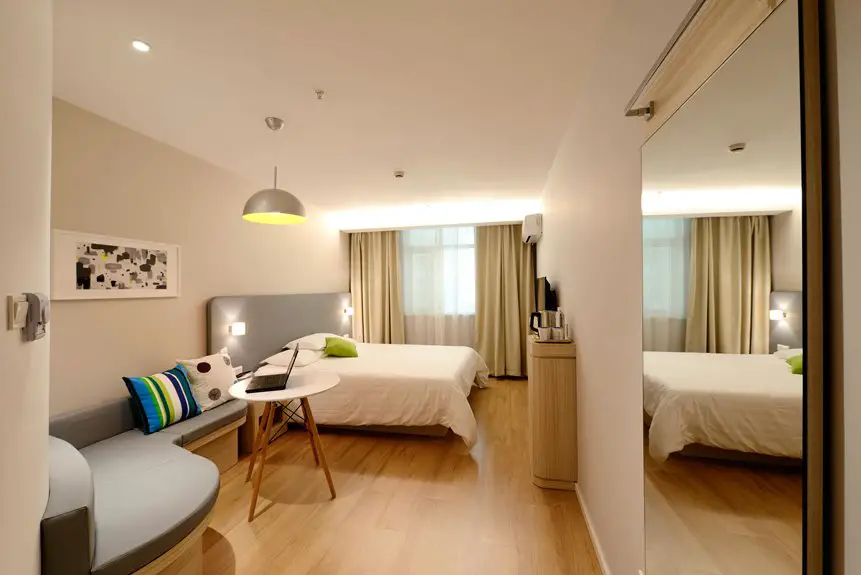To improve the acoustics of your high-ceiling room, start by using soft furnishings like plush rugs, thick curtains, and upholstered furniture to absorb sound. Incorporate acoustic panels on walls and consider ceiling treatments to reduce echoes. Strategically arrange furniture to disrupt sound waves and enhance comfort. Adding sound masking solutions can further obscure unwanted noise. Want to discover more effective strategies to create a balanced acoustic environment? There are plenty of options to explore!
Table of Contents
Key Takeaways
- Use plush rugs or carpets to absorb sound and reduce echo on hard surfaces.
- Hang heavy, floor-to-ceiling curtains to block light and dampen noise effectively.
- Install acoustic panels or foam to manage sound reflections and enhance clarity.
- Rearrange furniture to disrupt sound waves and minimize reflections in the space.
- Consider sound masking solutions like white noise machines to obscure unwanted noise.
Understanding the Acoustic Challenges of High Ceilings
When you walk into a room with high ceilings, you might immediately notice how sound behaves differently than in spaces with lower ceilings. The vertical space allows sound waves to travel farther before dissipating, which can lead to echoes and a lack of clarity.
You may find conversations harder to follow, as voices can get lost in the vastness. The larger volume also means that sounds can take longer to reach your ears, making the room feel noisy or disjointed.
Additionally, hard surfaces like walls and ceilings can reflect sound, amplifying these issues. Understanding these challenges is vital for creating a comfortable acoustic environment, allowing you to take steps towards improvement tailored to your space’s unique characteristics.
Utilizing Soft Furnishings to Absorb Sound
Although high ceilings can create an echoey environment, utilizing soft furnishings can greatly enhance a room’s acoustics.
Start by adding plush rugs or carpets to absorb sound and reduce reverberation. You can also opt for thick curtains that not only block light but also dampen noise.
Consider incorporating upholstered furniture, like sofas and chairs, which can absorb sound waves effectively. Adding cushions and throws can further enhance this effect, creating a cozy atmosphere while improving acoustics.
Don’t forget about wall hangings or fabric wall art, as these can help break up sound reflections.
Incorporating Acoustic Panels and Wall Treatments
Now that you’ve explored soft furnishings, it’s time to contemplate acoustic panels and wall treatments for enhancing your room’s sound quality.
You’ll find a variety of panel types and wall options that can notably reduce echoes and improve overall acoustics.
Let’s look at how you can select the best solutions for your space.
Types of Acoustic Panels
Acoustic panels come in various types, each designed to tackle specific sound issues in your space.
You’ll find foam panels that absorb high-frequency sounds, making them ideal for home studios or music rooms.
Fabric-wrapped panels offer both aesthetic appeal and sound absorption, suitable for offices or lounges.
For a more sophisticated look, consider wooden acoustic panels, which can enhance both sound quality and design.
You’ll also encounter bass traps, specifically engineered to manage low-frequency sounds, perfect for corners where bass tends to accumulate.
Finally, ceiling-mounted panels can effectively reduce sound reflections in rooms with high ceilings.
Wall Treatment Options
When it comes to enhancing room acoustics, you’ve got several wall treatment options that can effectively incorporate acoustic panels.
Start by installing fabric-wrapped panels, which absorb sound while adding a stylish touch. Alternatively, consider using wood slat panels, combining aesthetics with functionality.
If you want a more budget-friendly approach, opt for DIY solutions, like mounting foam panels or hanging thick textiles like curtains or tapestries.
Additionally, you can create a feature wall with strategically placed art that doubles as sound absorption. Don’t forget to cover corners with bass traps, improving low-frequency response.
Adding Rugs and Carpets for Improved Sound Quality
Adding rugs and carpets can greatly enhance your room’s sound quality by absorbing excess sound.
When you choose the right materials and place them strategically, you’ll maximize their effectiveness.
Let’s explore how to select the best options for your space and where to position them for ideal results.
Sound Absorption Benefits
Rugs and carpets can transform a room’s sound quality, making your space feel more inviting and comfortable. By adding these soft materials, you’ll notice a reduction in echo and background noise, enhancing your listening experience.
When sound waves hit hard surfaces, they bounce around, creating that unpleasant reverberation. However, rugs and carpets absorb those sound waves, resulting in clearer audio for conversations, music, or movies.
You’ll also find that a well-placed carpet can help define different areas within a larger room, further enhancing the acoustics. Plus, the added warmth and texture can make your space feel cozier.
Choosing the Right Materials
Choosing the right materials for your rugs and carpets can greatly enhance sound quality in your space. Opt for thick, plush fabrics like wool or nylon, as they absorb sound better than thinner materials.
Natural fibers often provide superior sound dampening and warmth, making them an excellent choice for high-ceilinged rooms.
When selecting rugs, consider those with a dense pile, which can trap sound waves and reduce echo. Avoid shiny materials like polyester, as they may reflect sound rather than absorb it.
Additionally, look for rugs with a rubber backing, which can help minimize vibrations.
Placement for Maximum Effect
Placement plays a significant role in maximizing the acoustic benefits of your rugs and carpets. To effectively absorb sound, position rugs in areas where sound waves tend to bounce, such as under furniture or in open spaces.
If you’ve got a large room, consider placing multiple smaller rugs rather than one big one—this can break up sound reflections more effectively.
Don’t forget corners; placing a rug in a corner can help reduce echo. Layering carpets can also enhance sound absorption, particularly if you mix textures.
Finally, experiment with different placements to find what works best for your space. With a little trial and error, you’ll create a cozy atmosphere while improving your room’s acoustics.
Strategically Placing Furniture to Break Up Sound Waves
While you might not think about it, strategically placing furniture can greatly enhance your room’s acoustics by breaking up sound waves. By arranging furniture thoughtfully, you can minimize echo and create a more balanced sound environment. Here are some tips to take into account:
| Furniture Type | Placement Tips |
|---|---|
| Sofas | Position them against walls |
| Bookshelves | Use as sound barriers |
| Area Rugs | Place on hard floors for absorption |
| Chairs | Cluster them to create effective sound zones |
Experiment with different arrangements to find what works best for your space. You’ll notice that the right setup can make a significant difference in how sound travels, making your high-ceiling room feel cozier and more inviting.
Using Curtains and Drapes for Enhanced Sound Control
When you want to enhance your room’s acoustics, consider using curtains and drapes as a simple yet effective solution. Heavy, thick fabrics absorb sound waves, reducing echo and improving overall sound quality.
Opt for floor-to-ceiling curtains to cover more surface area, which helps minimize sound reflections from high ceilings. To maximize their effectiveness, hang the curtains as close to the ceiling as possible, allowing them to cascade down while avoiding gaps.
Layering different textures can also improve sound absorption, so mix materials like velvet and cotton. Don’t forget to open and close them as needed; this flexibility allows you to control light and sound simultaneously.
With the right curtains, you can create a more pleasant auditory environment in your high-ceilinged room.
Exploring Ceiling Treatments and Design Options
To enhance your room’s acoustics, exploring ceiling treatments can make a significant difference. Start by considering acoustic panels, which can absorb sound and reduce echo. These panels come in various designs and colors, allowing you to complement your room’s aesthetic.
You might also look into suspended ceilings with acoustic tiles, which not only improve sound quality but can also lower the ceiling height, making the space feel cozier.
Another option is adding decorative beams or coffered ceilings, which can break up sound waves and add visual interest. Don’t forget about installing sound-absorbing materials like fabric-covered panels or even strategically placed ceiling-mounted baffles.
Each of these options can transform your high-ceilinged room into a more acoustically balanced environment.
Implementing Sound Masking Solutions
As you seek to create a more peaceful environment, implementing sound masking solutions can be an effective strategy.
Sound masking involves adding background noise to your space, which helps to obscure unwanted sounds and enhance privacy. You can install sound masking systems that emit a consistent, soft sound, similar to a fan or gentle rain. This can be particularly useful in rooms with high ceilings, where sounds may bounce around and amplify.
Additionally, consider using white noise machines or apps if you’re looking for a more portable option. By creating a uniform sound environment, you can greatly improve the comfort and functionality of your space, making it more conducive to focus and relaxation.
Considering Professional Acoustic Consultation and Solutions
Implementing sound masking solutions can greatly improve your environment, but sometimes, professional guidance is the best route for achieving ideal acoustics.
Hiring an acoustic consultant can help you identify specific issues in your space, such as echoes and sound leakage, that you might overlook. They can assess your room’s dimensions, materials, and usage, providing tailored solutions that fit your needs.
Whether it’s recommending sound-absorbing panels or suggesting layout changes, their expertise can save you time and money in the long run. Additionally, they can help you navigate building codes and best practices, ensuring your improvements are both effective and compliant.
Don’t hesitate to seek professional help—it could be the key to transforming your high-ceiling space into an acoustically balanced haven.
Frequently Asked Questions
Can Plants Help Improve Room Acoustics in High-Ceiling Spaces?
Yes, plants can help improve room acoustics in high-ceiling spaces. They absorb sound and reduce echo, creating a more pleasant environment. Incorporating larger plants or dense foliage can enhance these acoustic benefits even further.
What Types of Materials Are Best for DIY Acoustic Treatments?
Isn’t it fascinating how the right materials can transform sound? For DIY acoustic treatments, you’ll want to use dense foam panels, heavy curtains, carpeted surfaces, and wood to effectively absorb and diffuse sound waves.
How Do I Identify the Best Locations for Acoustic Panels?
To identify the best locations for acoustic panels, you’ll want to assess sound reflections in your space. Use your ears to find echo points, and test different placements to optimize sound quality effectively.
Will Soundproofing Significantly Reduce Noise From Outside Sources?
Yes, soundproofing can greatly reduce outside noise. By adding insulation, sealing gaps, and using heavy curtains or specialized materials, you’ll create a quieter environment, making a noticeable difference in how sound enters your space.
How Much Do Professional Acoustic Consultations Typically Cost?
Professional acoustic consultations usually range from $100 to $300 per hour, depending on your location and the expert’s experience. It’s worth investing if you want tailored solutions for your specific acoustic challenges.




